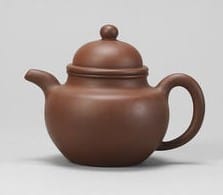Reduction Firing - Wuhui “Black” Yixing Teapots (焐灰)
History and Process
Wuhui (焐灰, “Smoldering Ash”)[1] is a reductive kiln-firing technique that imparts shades of black to natural zisha clay, with the depth of coloration depending on the clay's iron content and surface texture. Wuhui is a type of yaobian (窑变, “kiln transmutation”)[2]: originally an accidental firing flaw, the rarity and striking black color of the resulting wares eventually endeared themselves to Qing dynasty literati[3] where these black-fired wares found their acceptance. The term wuhui refers both to the specific reduction firing process used to produce wuhui wares and the wares themselves.
Wuhui Yixing teapots have been dated to the late-Ming dynasty and the style varied in popularity throughout the Qing and RoC, ending only with the modernization of the early-F1 period. Cheng Shouzhen[4] (程寿珍, 1858 – 1939 CE), an acclaimed Yixing artist of the RoC era, was a known maker and proponent of wuhui wares; Cheng was known to have had many antique wuhui wares of the Qing dynasty in his personal collection.


A side-by-side example of the same zisha teapot in zini and wuhui (焐灰) zini by Cheng Shouzhen (程寿珍, 1858 – 1939 CE), c. 1915 CE. This wuhui image on the right was included in previous chapter Book 2 – An Abbreviated History of Yixing Teapots: Republic of China Yixing History. Left: Bonhams Fine Art Auction, Hong Kong; Right: Hong Kong Museum of Art.
This page is for paying subscribers only
Subscribe NowAlready have an account? Log in